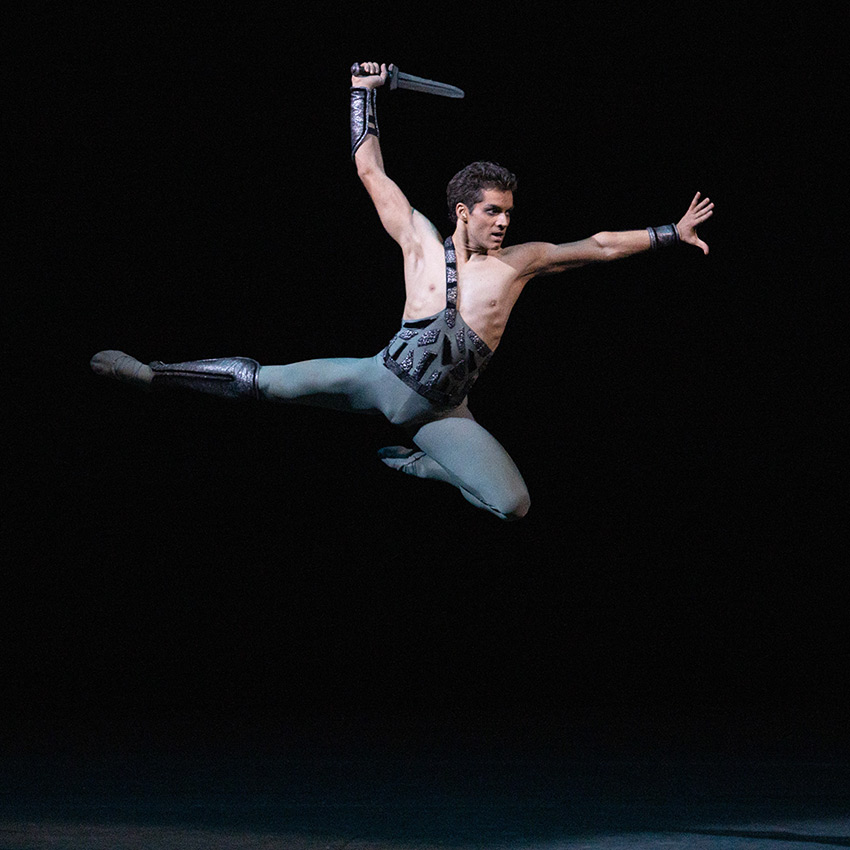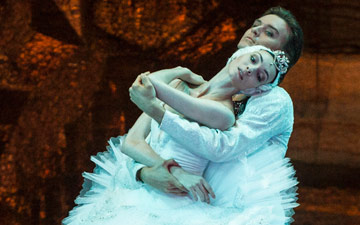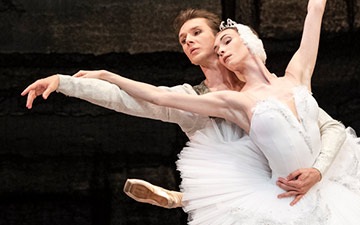
© Elena Fetisova. (Click image for larger version)
Bolshoi Ballet
Spartacus
★★★★✰
London, Royal Opera House
30 July 2019
www.bolshoi.ru
www.roh.org.uk
Exactly 50 years ago, the Bolshoi performed Yuri Grigorovich’s Spartacus for the first time in London, a year after it was created to celebrate the October Revolution. The 1917 uprising was led by Lenin’s Bolshevik Party, which aimed to bring about the downfall of the Tsarist regime and install a Soviet republic.
So, in the ballet, the classical story of enslaved Spartacus leading a rebellion against a despotic Roman ruler was intended to be seen as a heroic struggle against oppression. Spartacus, man of the people, may have been doomed (as was the Roman Empire) but his cause was just. Grigorovich made him a tragic hero, inspiring his supporters, and the audience, with his charismatic vigour. His enemy, Crassus, was backed by powerful forces – the Roman elite and the army.
Only the Bolshoi could do justice to the titanic contest between right and wrong. Grigorovich fills the stage with phalanxes of mighty male dancers, parting to allow the passage of Spartacus or Crassus in diagonals of hurtling leaps. Every move is writ large, easy to read and anticipated because there are so many repetitions, as there are in Aram Khachaturian’s score. Spartacus is a spectacle for the masses as well as for ballet-goers.
It is well constructed, never dull, with cinematic cuts between mass ensembles, passionate pas de deux and expressive solos by the leading characters. Scene changes, in set designs by Simon Virsaladze, are instant. Different genres of dance follow in swift succession: acrobatic, folk-influenced, militaristic, orgiastic, high life and low life. Spartacus’s camp includes goats and shepherds; Crassus’s society encompasses patricians and courtesans.
Grigorovich’s choreography is crudely effective, based on ballet but with ‘modern’ (in 1968) use of parallel positions, splayed legs and jazzy hip thrusts. Some of it looks ridiculous, but no more so than a lot of contemporary ballet choreography today. A duet for Spartacus and his lover, Phrygia, has her lying horizontal in mid-air, balanced on his upraised hand, as she caresses her leg with one foot, indicating her determination not be parted from him. Although the Bolshoi famously specialises in gravity defying lifts, Spartacus still stuns us with the feats it requires from its dancers.
Performed on Tuesday night by Maria Vinogradova as Phrygia and Igor Tsvirko as Spartacus, the pas deux register as convincing expressions of a whole range of emotions, buoyed by the soaring music. She is loyal and vulnerable, he is torn between love, duty – and maybe ambition. In today’s interpretation of the ballet’s story, Spartacus can come across as a fatally flawed leader, not to be trusted.

© Mikhail Logvinov. (Click image for larger version)
True, Tsvirko has the macho allure of a Che Guevara, posturing heroically, eyes flashing: you’d follow him anywhere. He’s tireless, powering himself into the air, spinning like a gyroscope. But there are hints that he is as vainglorious as Crassus (Artem Ovcharenko). Spartacus postures with his motley crew of rebels in much the same way as Crassus with his Roman legions. Both are in charge of violent thugs. There’s an implicit warning that populist agitators like Spartacus, trying to control discontented factions, can become dictators.
Ovcharenko’s Crassus is not as brutal as some interpreters have made him. For one thing, Ovcharenko is slighter than Tsvirko’s Spartacus and no match for him in a gladiatorial bout. He’s a loser, trying to bluff his way in polite Roman society with a vulgar mistress, Aegina, in his entourage. Olga Smirnova as Aegina is miscast against type. She’s an Odette, not a showgirl. She tries hard to take bold strides and stretch her legs into off-balance extensions but her feet stutter. They want to find an academic fifth position, not a vamp’s stance. Not for any money could she plausibly seduce a campful of mercenary gladiators and turn them against Spartacus.
Elsewhere, however, Tuesday’s cast were totally committed to their roles, giving the Soviet warhorse renewed life. The corps of warriors, shepherds, courtesans, aristocrats, rebels and mourners know how vital they are to the ballet’s impact, even as the leaps and lifts of the principals rouse the audience to enthusiastic applause. The messages of Grigorovich’s Spartacus may have changed over the half-century since its creation but new generations revel in its theatricality – and the bolshoi power of its performers.

















You must be logged in to post a comment.